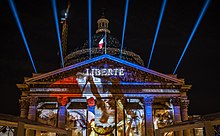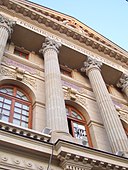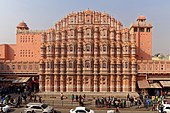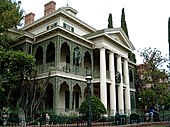What Does Facade Mena Again Facade Mean Again


A façade ()[ane] is generally the front part or exterior of a building. It is a loan word from the French façade (pronounced [fasad]), which means 'frontage' or 'face'.
In architecture, the façade of a building is often the virtually of import aspect from a blueprint standpoint, equally it sets the tone for the rest of the building. From the engineering perspective, the façade is also of great importance due to its bear on on energy efficiency.[2] For historical façades, many local zoning regulations or other laws greatly restrict or even forbid their amending.
Etymology [edit]
The word is a loanword from the French façade , which in turn comes from the Italian facciata , from faccia meaning 'confront', ultimately from post-classical Latin facia . The earliest usage recorded by the Oxford English language Dictionary is 1656.[3]
Façades added to earlier buildings [edit]
It was quite common in the Georgian flow for existing houses in English language towns to be given a stylish new façade. For example, in the urban center of Bath, The Bunch of Grapes in Westgate Street appears to exist a Georgian edifice, but the appearance is just peel deep and some of the interior rooms still have Jacobean plasterwork ceilings.[4]
This new structure has happened also in other places: in Santiago de Compostela the three-metre-deep Casa do Cabido was built to match the architectural order of the square, and the primary Churrigueresque façade of the Santiago de Compostela Cathedral, facing the Praza do Obradoiro, is actually encasing and concealing the older Portico of Glory.
Loftier rise façades [edit]
In modern high rise building, the outside walls are frequently suspended from the concrete floor slabs. Examples include curtain walls and precast physical walls. The façade tin at times exist required to have a fire-resistance rating, for case, if two buildings are very close together, to lower the likelihood of fire spreading from one building to another.
In general, the façade systems that are suspended or fastened to the precast concrete slabs will be made from aluminium (pulverization coated or anodized) or stainless steel. In recent years more lavish materials such as titanium have sometimes been used, just due to their cost and susceptibility to panel edge staining these have non been pop.
Whether rated or non, fire protection is always a design consideration. The melting signal of aluminium, 660 °C (1,220 °F), is typically reached within minutes of the start of a fire. Fire stops for such building joints tin be qualified, likewise. Putting burn down sprinkler systems on each flooring has a profoundly positive event on the burn down safety of buildings with curtain walls.
The extended use of new materials similar polymers, resulted in an increase of loftier-ascent building facade fires over the past few years, since they are more than flammable than traditional materials.
Some edifice codes besides limit the percent of window surface area in exterior walls. When the exterior wall is not rated, the perimeter slab edge becomes a junction where rated slabs are abutting an unrated wall. For rated walls, 1 may also cull rated windows and burn down doors, to maintain that wall's rating.
Moving-picture show sets and theme parks [edit]
On a motion-picture show prepare and within most themed attractions, many of the buildings are only façade, which are far cheaper than actual buildings, and not subject to building codes (within film sets). In film sets, they are merely held up with supports from behind, and sometimes have boxes for actors to stride in and out of from the front if necessary for a scene. Within theme parks, they are commonly decoration for the interior ride or attraction, which is based on a simple building design.
Examples [edit]
-

-

Façade of a house from Ansbach (Frg)
-
The Haunted Mansion in Disneyland consists of a edifice and façade in the front, while the majority of the ride is outside the park in a connected edifice
-

Fantasy Gardens (British Columbia) was a theme park with an exterior designed to resemble many different medieval buildings
-

-
"Energetic rebuilding of a façade" (Germany): The outer walls are torn off and replaced at 1 wing of the building at a time while the other wing part is nevertheless/again in use
-

Come across also [edit]
- Curtain wall (compages)
- Double-skin facade
- Facadism
- Potemkin village
References [edit]
Citations [edit]
- ^ lexicon.cambridge.org
- ^ Boswell, Keith (2013). Exterior Edifice Enclosures. John Wiley & Sons. p. 11.
- ^ "façade, due north.". Oxford English dictionary (Second, online ed.). Oxford University Printing. December 2011 [1989]. (subscription required)
- ^ Jean Manco. Bath's lost era, "Bath and the Great Rebuilding", Bathroom History vol. four, (Bath 1992). Get-go published in Bathroom City Life Summer 1992. Retrieved 22 June 2010
Sources [edit]
- Façades: Principles of Construction. Past Ulrich Knaack, Tillmann Klein, Marcel Bilow and Thomas Auer. Boston/Basel/Berlin: Birkhaüser-Verlag, 2007. ISBN 978-iii-7643-7961-two (German) ISBN 978-3-7643-7962-nine (English)
- Giving buildings an illusion of grandeur
- Facades of Casas Chorizo in Buenos Aires, Argentine republic
Further reading [edit]
| | Await up facade in Wiktionary, the free dictionary. |
- Poole, Thomas (1909). . In Herbermann, Charles (ed.). Catholic Encyclopedia. Vol. 5. New York: Robert Appleton Company. The article outlines the development of the facade in ecclesiastical architecture from the early Christian period to the Renaissance.
Source: https://en.wikipedia.org/wiki/Fa%C3%A7ade


0 Response to "What Does Facade Mena Again Facade Mean Again"
Post a Comment